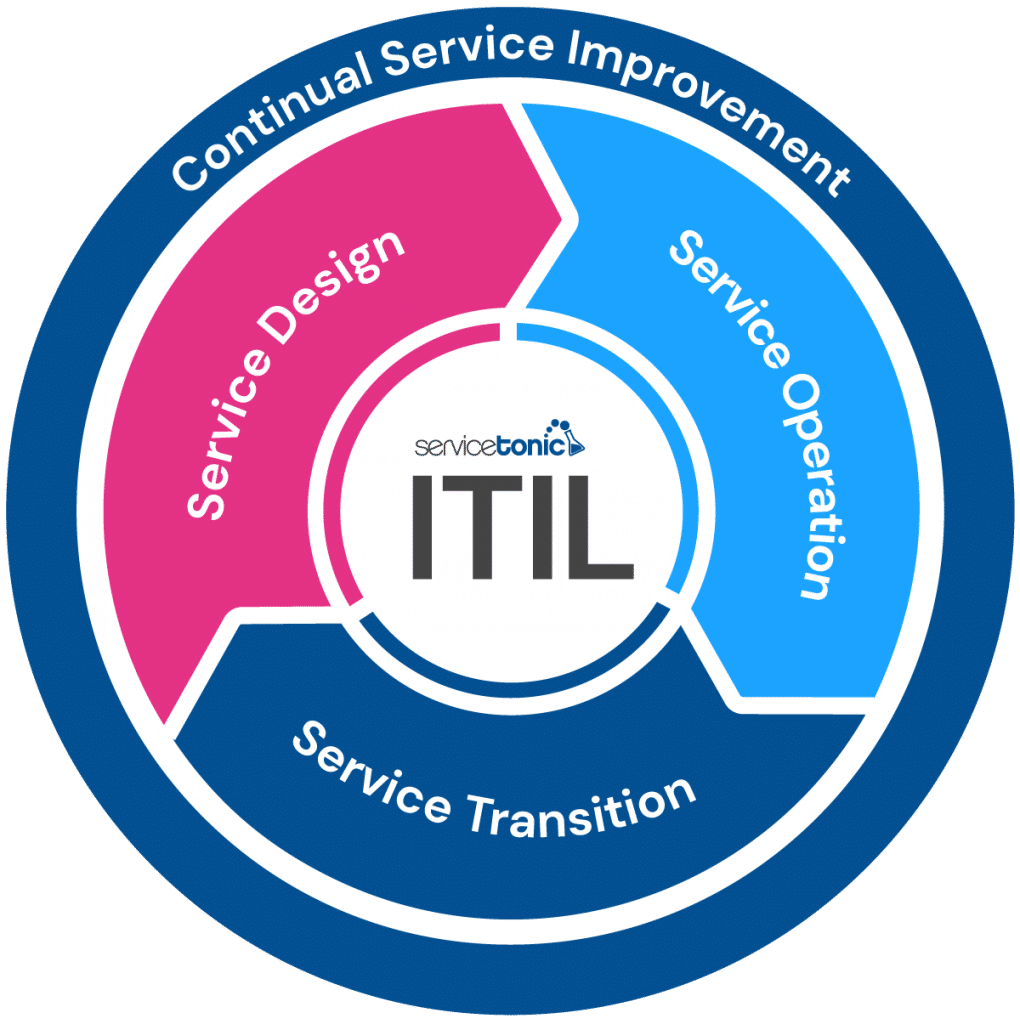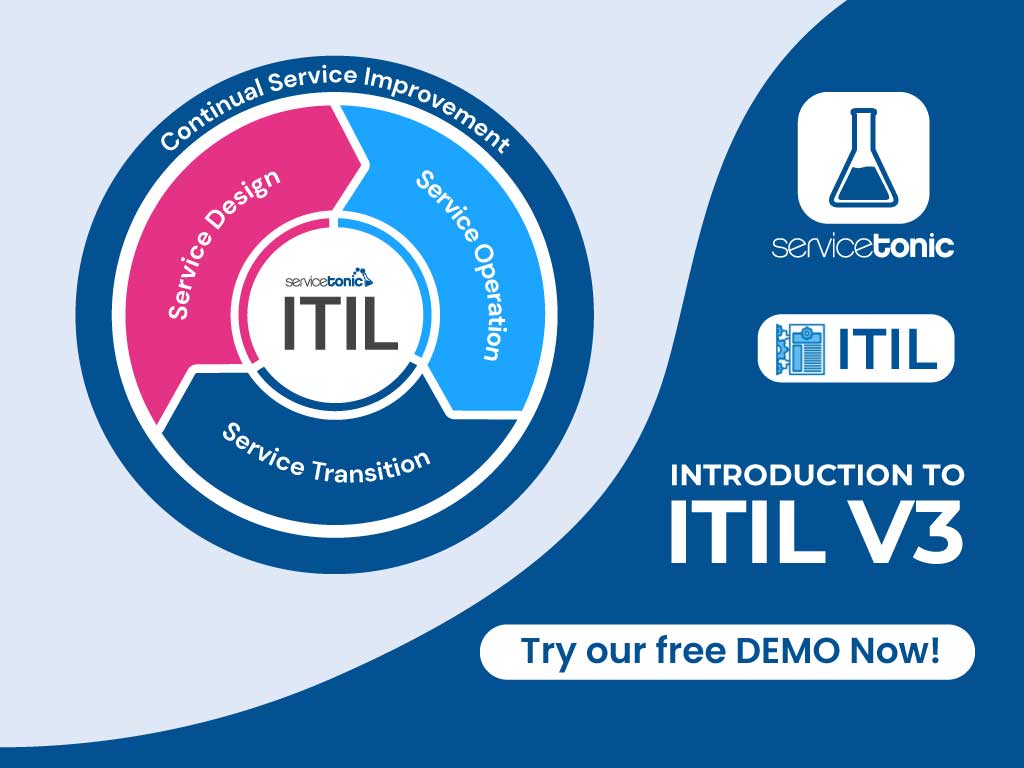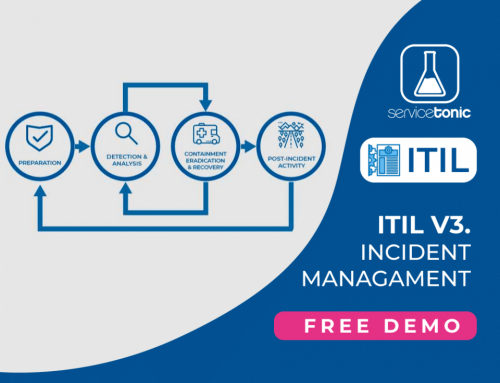Table of Contents
ITIL is the reference in the world of IT Service Management
What is ITIL?
ITIL is currently the most accepted and used framework in the world of IT Service Management.
It is a set of concepts and best practices regarding the management of IT services, and describes in detail an extensive set of functions and processes designed to help organizations achieve quality and efficiency in IT operations.
ITIL v3, the latest version of ITIL, is structured in the following 5 books with the objective of consolidating the “service lifecycle” model: Service Strategy, Service Design, Service Transition, Service Operation and Continuous Service Improvement.
Service Strategy
In the center of the Service Lifecycle, we find Service Strategy. It promotes the vision of service management as a strategic asset, not just as an organizational capability.
Organizations should use the strategy as an orientation in the following aspects:
- Identify, select and prioritize business opportunities.
- Create distinctive aspects regarding competition that reinforce market positioning.
- Ensure that the organization is able to support the cost and risk associated with its service catalog.
- Improve the alignment of Service Management capabilities with business strategies.
- Ask yourself what services should be implemented and why before you ask how to do it.
The processes associated with the service strategy are as follows:
Financial management
- Provides financial assessment on services and their infrastructure as well as a forecast of costs.
- Models the demand using pricing mechanisms to influence customer consumption patterns.
Service portfolio management
It manages investments in new services and in the updating of existing services taking into account the following key factors:
- Is it a salable service? Why would customers buy it? Why would they buy it from us?
- Is it a profitable service? What are its costs? How would we charge for it?
- Is it a workable service? How would it be managed?
Demand management
Its purpose is to predict and regulate demand, so that the use of resources is optimized and rationalized. It is responsible for redistributing the available capacity to provide the services of the service catalog with the quality agreed with the client.

Service Designs in ITIL V3
In this book, ITIL provides the design principles and methods necessary to convert strategic business objectives into a service catalog with its associated assets.
The main objective of Service Design is to design new or modified services, in line with the business objectives established in the Service Strategy, to be included in the Service Catalog and subsequently implemented in production.
The processes associated with the Service Strategy are as follows:
Service Catalog management
Ensure to keep the Service Catalog completed, updated and accessible.
Service Level management
Negotiates, agrees, documents and maintains the service quality objectives. It monitors and reports the levels of compliance achieved during the execution of the service.
Capacity management
Responsible for ensuring that the organization has the resources to provide services with the agreed quality level.
Availability management
Responsible for monitoring and optimizing services to provide the level of availability agreed with the client with the lowest cost and risk possible.
Continuity management
Prevents that an unforeseen and serious interruption of services, due to natural disasters or other forces of major cause, have catastrophic consequences on the business. To this end, disaster contingency plans of different magnitude should be developed.
Supplier management
Negotiates and agrees the contracts with the suppliers, establishing the corresponding UC (Underpinning Contract).
Information Security management
Responsible for developing and maintaining the Information Security Policy (ISP), which establishes the policies of integrity, confidentiality and availability of information.
Service Transition in ITIL V3
The main objective of the Service Transition stage is the implementation of new or modified Services with the minimum impact for the business and within the expected parameters of cost, time and quality.
Having an effective Service Transition endows the organization with adaptability to change, a fundamental aspect in today’s changing environments and markets.
The processes associated with the Service Transition are as follows:
Planning and support to Transition
Plans and coordinates resources to ensure that the requirements of Service Strategy reflected in the Service Design are met in Service Operation. It must also ensure that the production of a new or modified service is carried out successfully and within the foreseen parameters of cost, time and quality.
Change Management
Oversees and approves the introduction of new services or modification of services ensuring that the whole process of change has been properly planned, tried out, tested, implemented and documented.
Configuration management and service assets
Responsible for the registration and management of configuration items (CIs) and service assets. This process supports virtually all aspects of Service Management.
Release and Deployment management
Responsible for developing, testing and deploying new versions of services according to the guidelines set in the Service Design phase.
Service validation and testing
Responsible for ensuring that services meet the established requirements before passing to production.
Evaluation
Evaluates and reports those relevant aspects of services: quality, profitability, customer satisfaction, etc.
Knowledge management
Makes available the knowledge accumulated in the service to all processes associated with any stage of the Service Lifecycle.
Service Operation in ITIL V3
Service Operation is the phase in which services truly add value to the business and where the Service Lifecycle plans, designs and improvements are executed and evaluated.
It is responsible for carrying out all the activities necessary for the provision and support of the services. It is also the phase where Continuous Improvement phase gets more information from.
The processes associated with the Operation of the Service are as follows:
Event management
Monitors all events that occur in the service infrastructure and alerts from situations that could become an incidence.
Incident management
Restores disrupted or degraded services as soon as possible so minimize the business impact.
Service Request management
Provides information about the Service Catalog to users and a channel for users to apply predefined and pre-approved services.
Problem management
Diagnoses the root cause of incidences, provides workarounds to incident management to restore services as soon as possible and proactively takes action to detect and prevent future incidents.
Access management
Grants authorized users the right to use a service and prevents access of unauthorized users.
The functions associated with the Operation of the Service are as follows:
Service Desk
Provides a point of communication between users and the service and coordinates groups and service processes.
IT Operations management
Runs the daily operations necessary for the infrastructure of the service to work.
Technical management
Provides detailed technical skills and resources necessary to support the operation of the service infrastructure.
Application management
Responsible for managing the IT applications lifecycle.
Continuous Service Improvement in ITIL V3
The main objective of Continuous Service Improvement is to align and realign services with changing business needs by identifying and implementing improvements.
The rest of the phases of the Service Lifecycle are scope of this phase, since it is always possible to improve the strategy, design, transition, and operation of the services.
El Ciclo de Deming: Planificar (Plan), Hacer (Do), Verificar (Check) y Actuar (Act) constituye la columna vertebral de todos los procesos de mejora continua:
- Plan: to establish the objectives and processes necessary to obtain the results according to the expected result.
- Do: Implement planned improvements. If possible, on a small scale.
- Check: After a pre-determined period, collect control data and analyze them, comparing them with the initial objectives and specifications to evaluate if the expected improvement has occurred.
- Act: depending on the outcome of the check phase:
- If you detect partial errors, perform a new PDCA cycle with further improvements.
- If you detect no relevant errors, apply modifications on a large scale.
- If you detect insurmountable errors, abandon the process modifications.
The processes associated to Service Continuous Improvement are the following:
Process Improvement
7 step process to implement process improvement. The steps are the following:
- Define what should be measured.
- Define what we can measure.
- Collect data
- Process the data.
- Analyze the data.
- Present and use information.
- Implement corrective actions.
Service Reports
Generates reports to evaluate services and the results of the proposed improvements.



